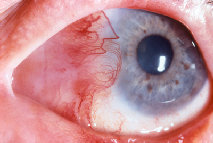Pterygium (Surfer’s Eye)
Ptergia are very common with an estimated 3 million procedures performed each year. The cases tend to be concentrated in sunny areas and are more common in the Hispanic population . Wind is a contributing factor as well.
The small fleshy growth can lead to chronic redness and irritation

The growths can be removed if growing, red or irritated despite conservative treatment (drops, avoidance of sun/wind) and possibly a course of steroid eye drops.
The techniques vary and some are prone to higher recurrence rates. We use the most advanced techniques with no stitches using a graft from the patient’s own eye. Some centers use Amniotic Membrane grafts from an unrelated donor.
In recurrent cases we can use mitomycin to largely prevent recurrence.
What is a pterygium
A pterygium is a fleshy growth that invades the cornea (the clear front window of the eye). It is an abnormal process in which the conjunctiva (a membrane that covers the white of the eye) grows into the cornea. A pterygium may be small or grow large enough to interfere with vision and commonly occurs on the inner corner of the eye.
What causes a pterygium?
The exact cause is not well understood. A pterygium occurs more often in people who spend a great deal of time outdoors, especially in sunny climates. Long-term exposure to sunlight, especially ultra-violet (UV) rays, and chronic eye irritation from dry, dusty conditions seem to play an important causal role.
How is a pterygium treated?
When a pterygium becomes red and irritated, topical eyedrops or ointments may be used to help reduce the inflammation. If the pterygium is large enough to threaten sight, is growing or is unsightly, it can be removed surgically.
Despite proper surgical removal, the pterygium may return, particularly in young people. Surface radiation or medications are sometimes used to help prevent recurrences. Protecting the eyes from excessive ultraviolet light with proper sunglasses and avoiding dry, dusty conditions may also help.
